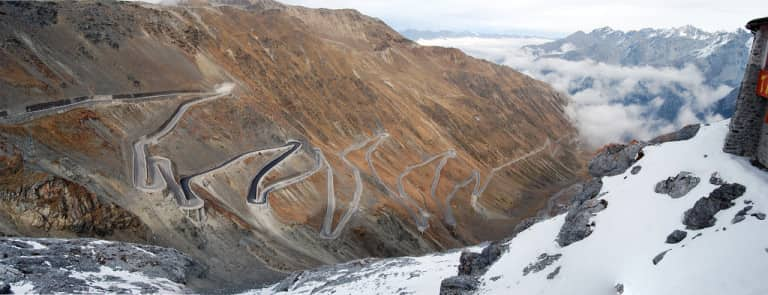The Stelvio Pass, Passo dello Stelvio in Italian, located in the Italian Alps at 2,757 meters (9,045 feet) above sea level, is the highest paved mountain pass in the Eastern Alps, and the second highest in the Alps, surpassed only by the Col de l’Iseran, which is at 2,764 meters (9,065 feet). The pass ranks among the 25 highest mountain passes in Europe. The pass is located in the municipality of Bormio, in the Lombard province of Sondrio, near the border with the province of Bolzano.
| Country | Italy |
| Mountain range | Alps |
| Coordenates | 46°31′48″N 10°27′14″E |
| Average gradient | 7,4% |
| Maximum gradient | 11% |
| Elevation | 2,758 mt (9,049 ft) |
| Gradient | 1,808 mt (5,932 ft) |
| Lenght | 24,3 km (15,1 mi) |
At the summit, a cable car connects to the ski resort of the same name, which also operates in the summer. The pass is a myth for cycling enthusiasts in the summer, as the climb has been one of the most important stages of the Giro d’Italia for years. The pass remains closed during the winter months, typically from November to April, as snow makes passage impossible.
Thanks to the Stelvio Pass, tourism in Valtellina has been developing year after year, and today it is one of the key points for skiing in Europe during the summer.
Driving on the Stelvio Pass is challenging due to the 48 hairpin bends that make up the ascent and some very narrow sections. This road is undoubtedly one of the most spectacular to drive in the world.
Location
The Stelvio Pass is located in the Italian Alps, specifically in the municipality of Bormio, in the Lombard province of Sondrio, near the border with the province of Bolzano.
What to see
Stelvio National Park

The pass is located within Stelvio National Park, the largest national park in Italy, covering over 130,000 hectares. If you’re planning to travel to Italy and you love nature, forests, glaciers, waterfalls, and mountains, don’t hesitate to visit this place. On the website www.italia.it, you can find more information about the park, including details about flora, fauna, trails, guided tours, and hotels.
Bormio
Visit the charming town of Bormio, located near Passo dello Stelvio, known for its thermal baths, historic architecture, and picturesque streets. Take a stroll through the town center, sample local cuisine at restaurants, and relax in the thermal spas after a day of outdoor activities.
Best Times to Visit
The best time to visit Passo dello Stelvio is during the summer months, typically from late May to early November, when the pass is open and accessible. This period offers favorable weather conditions for outdoor activities and sightseeing. However, it’s essential to check road conditions and closures before planning your visit, as the pass may be closed during inclement weather or winter months due to snow.
The Stelvio Pass in the Giro d’Italia

The Stelvio Pass is one of the most emblematic climbs of the most important Italian cycling race, the Giro. It has been climbed in a total of eleven editions (up to 2020) and is the quintessential Cima Coppi of the race (since 1965, the highest pass climbed each year in the Giro is designated as the Cima Coppi, so it changes every edition). It was first climbed in the year 1953.
| Year | Winner | Country |
|---|---|---|
| 1953 | Fausto Coppi (ITA) | |
| 1965 | Graziano Battistini (ITA) | |
| 1972 | José Manuel Fuente (SPA) | |
| 1975 | Francisco Galdós (SPA) | |
| 1980 | Jean-René Bernaudeau (FRA) | |
| 1994 | Franco Vona (ITA) | |
| 2005 | Iván Parra (COL) | |
| 2012 | Thomas de Gendt (BEL) | |
| 2014 | Dario Cataldo (ITA) | |
| 2017 | Mikel Landa (SPA) | |
| 2020 | Rohan DENNIS (AUS) |
History of the Stelvio Pass

The route that makes up the Stelvio Pass has existed since the Middle Ages, although it was a dangerously steep mountain path. In the early 19th century, the Emperor of the Austrian Empire, Francis I of Austria, wanted a new road to connect the Venosta Valley (near the borders of Austria and Switzerland) to Valtellina (north of Lombardy), and from there to Milan, which was Austrian territory at the time.
The project was overseen by mountain engineering expert Carlo Donegani, with construction starting in 1822 involving over 2,000 people, including engineers and geologists. In just three years, by 1825, the new road was inaugurated in the presence of the emperor himself.
Until 1915, the Stelvio Pass road was used year-round by travelers and merchants, thanks to the efforts of workers who cleared snow during the winter. During World War I, it witnessed clashes between Italians and Austrians, and after the battle on November 4, 1918, both sides of the pass came under Italian control, and Stelvio lost its original significance as a connection from Austria to Milan. At that time, it was decided to close the Stelvio Pass in winter, and today it is possible to cross it from late May to early November, being closed during the winter months.
Featured pic by absoluteczech



 (3 votes, average: 4.33 out of 5)
(3 votes, average: 4.33 out of 5)











